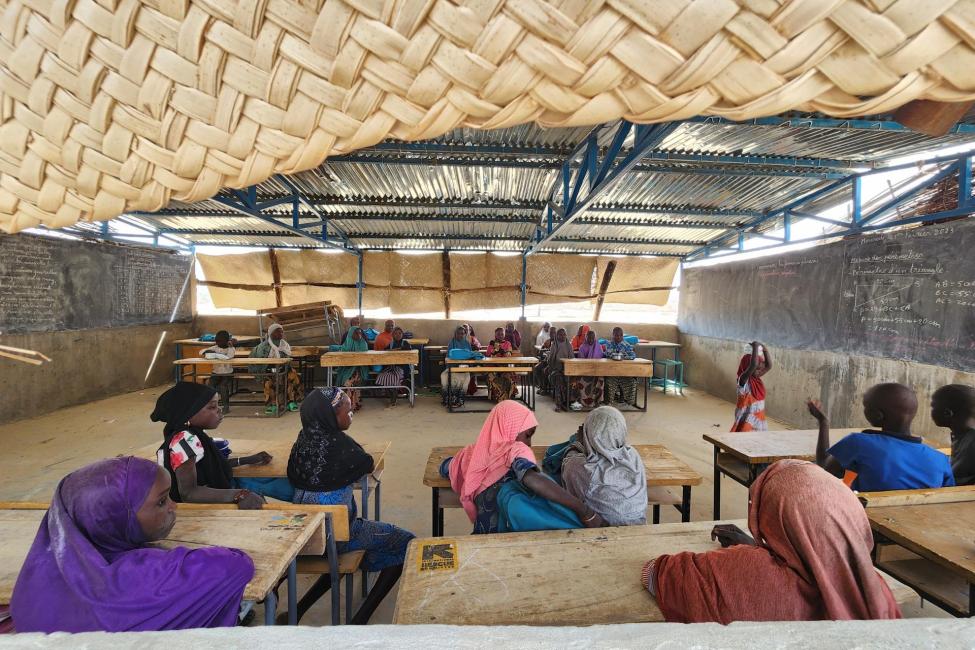-
Who We Are
WHO WE AREThe International Organization for Migration (IOM) is part of the United Nations System as the leading inter-governmental organization promoting since 1951 humane and orderly migration for the benefit of all, with 175 member states and a presence in over 100 countries. IOM has had a presence in Niger since 2016.
About
About
IOM Global
IOM Global
-
Our Work
Our WorkAs the leading inter-governmental organization promoting since 1951 humane and orderly migration, IOM plays a key role to support the achievement of the 2030 Agenda through different areas of intervention that connect both humanitarian assistance and sustainable development.
Cross-cutting (Global)
Cross-cutting (Global)
- Data and Resources
- Take Action
- 2030 Agenda
The highway connecting the Diffa region of Niger to the northeastern part of Nigeria is dotted with makeshift tents on the sides especially from Diffa to Gueskerou. The tents are home to thousands of displaced persons who have had to flee their homes for safety. Located in the Lake Chad Basin area of the Diffa region, the commune Gueskerou has been prone to attacks by violent extremist organizations since 2015, resulting in massive community displacement.
The Gueskerou site, located near the highway 35 kilometers from Diffa city, hosts over 15,000 displaced persons and Nigerian refugees. The site is a mere four kilometers from their former villages that were situated on the banks of the Komadougou Yobe, a tributary river of Lake Chad.
Boulama Loukouye, the chief of one of the villages that have found refuge in this site, recalls the night they left their homes.
"We left on Friday 24 October 2019, caught in the water, just after prayer," he says.
That night, the Komadougou Yobé river broke bank overflowing to the neighboring villages of Boulama, sweeping away houses and personal belongings. The desperate inhabitants left the villages the same evening to seek refuge in higher grounds - the Gueskerou site.
"When we first arrived on the site, there was nothing.," explains Boulama. "The women would go dozens of kilometers to fetch water. Some organizations supported us with water, but it wasn't enough," he adds.
In December 2022, the site inaugurated a borehole and a water system to cover the water needs of the displaced populations. Eight public fountains were installed in the villages, and two new fountains in a nearby school and health center. Additionally, the site being located on a transhumance corridor, four watering points to cater for the nomadic movement were installed.
"Thank God we now have this big borehole, a treasure, which supplies us with enough water. We are not thirsty anymore," says Boulama.
The new water system provides safe drinking water to the population and contributes to improving hygiene and sanitation and to reducing illnesses such as diarrhea. This further addressed the conflict between local communities and headers for the limited resources.
This support is a great step towards rebuilding the displaced livelihoods on the site. However, insecurity shattered their dreams of returning to their homes as violent extremist groups settled on their lands after their departure. Only a few kilometers them from their former lives, yet it appears so far away and unattainable to them.
"Before the floods, there were intermittent attacks by armed groups, but we held on. We stayed because our entire life was there. But since we left, we are not thinking of going back because the floods are not likely to stop, and there is insecurity. It's very isolated and dangerous," says Boulama.
As they slowly settle on the site, the group dreams of recovering the infrastructure they left behind.
"We had many activities. We were fishing, raising livestock, and farming. We had all the necessary infrastructures, a health center, an elementary school, a kindergarten, our community radio, the town hall, and even a youth training center. There was also a market. It was a bustling area. Our biggest dream is to have all these infrastructures back", he adds.
For now, the only social amenities available at the site is an overcrowded health center, and a school mainly comprised of emergency classrooms.
Despite all these, the community remains resilient. They continue to strive for a better life, notwithstanding the various challenges they face.
Education remains uninterrupted for the children in the site, women continue to engage in small-scale trade at the weekly markets, the older men continue to tend to the farms in areas les flooded, while the younger men go fishing. – All this while facing the risk of attacks from violent extremist groups.
"Young people go fishing. They return to our villages of origin, to the Komadougou Yobé River; they go there in the morning and return in the evening. They say they must earn a living even if they risk their lives. We are scared too when they go; we are worried they might never return," said Boulama.
Despite the situation, Boulama and the inhabitants of the Gueskerou site have high hopes.
"We pray for the economic development of this site. We dream of markets with many traders, especially women, to revive the economy. We have secured land not far from this site to the north, in a safer area. We also hope to have water there so we can irrigate our farmland. We want to resume the life we had before," Boulama concludes.
The water system and borehole were built as part of IOM's Niger Community Cohesion Initiative (NCCI) with funding from the European Union's Service for Foreign Policy Instruments (FPI). The NCCI seeks to increase communities' cohesion and resilience to conflict, insecurity, and threats by violent extremist organizations and strengthen their trust in local government authorities and state structures.




